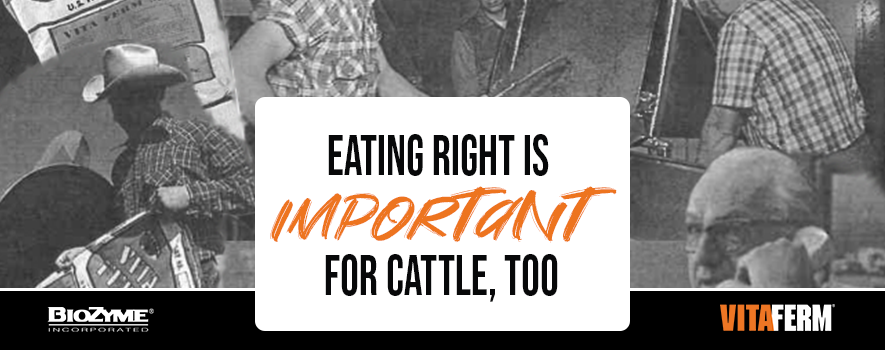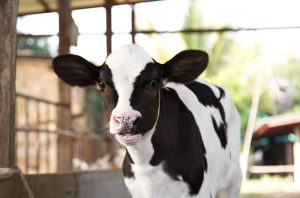Fourth in a Series based on 1980s Ads Featuring BioZyme® Founder

Who doesn’t enjoy a properly prepared, balanced meal? For some, an ideal dinner might include a juicy, grilled steak packed with zinc, iron, protein, amino acids and multiple B vitamins, a green leafy salad filled with fiber, Vitamins A & C, a baked potato, that includes potassium, carbohydrates and other important vitamins, and even a bowl of ice cream that provides calcium, riboflavin and niacin. Your cattle are no different. Eating a healthy, balanced meal is important for their overall health and productivity.
“Eating right. It does for your cattle, what it does for you,” is the headline in one of the 8×10 advertisements from the 1980s for BioZyme®’s VitaFerm ® products. It features the company founder in his suit and tie seated at a table about to dine on the kind of meal previously described. The copy then states, “Like us, cattle need a balanced diet to perform well. They need good food. Plenty of water. And don’t forget vitamins and minerals. That’s where VITA FERM comes in.”
VitaFerm is a line of nutritional supplements for beef cattle that maximize energy and forage utilization for successful production. There are variety of VitaFerm minerals that fit multiple needs and price points. All VitaFerm products contain AO-Biotics® Amaferm®, a prebiotic research-proven to enhance digestibility. Another line of mineral in the BioZyme family of products that Ehlert would likely be proud of that contains Amaferm is Gain Smart®. Gain Smart is a line of vitamin and mineral supplements for stocker cattle that promotes healthy, economical pounds by maximizing the energy and protein available in the diet.
As producers start thinking about turning cows onto pasture and planning their breeding strategies, they need to consider their nutritional plans. Even with extreme amounts of rain and snow across much of the U.S. this winter, the lush, green grass doesn’t always provide everything that cows need. The same can be said for fall-born calves soon to be weaned and turned out to pasture.
Chris Cassady, Ph.D., Beef Technical Sales Manager, cautions producers to be mindful of grass tetany when pastures are lush.
“Grass tetany occurs when high potassium and nitrogen levels in the plant interfere with magnesium absorption in the ruminant, leading to a deficiency. This can and should be easily alleviated by providing a high-mag mineral for at least three weeks before turnout on lush forage. Minerals are a tiny component of a transition diet for rebreeding, but can-do big things when it comes to achieving your reproductive goals,” Cassady said.
A mineral like VitaFerm Concept•Aid® Mag/S contains magnesium to help prevent grass tetany. It also includes organic copper, iodine and zinc for maximum bioavailability, innate immunity and hoof health, as well as high levels of Vitamin E to support reproductive tract repair and milk quality, all things important as those cows continue with lactation and prepare for rebreeding.
Other considerations this time of year is making sure that your herd has adequate protein and energy. Just because you have fresh, green pastures doesn’t mean those green grasses have plenty of either. When in doubt, get your forages tested.
“Nearly all of the protein in these immature forages is in the degradable form (RDP), meaning the microbes in the rumen quickly break down these proteins to ammonia. Not only can this lead to bloat issues, but if energy is limited, this ammonia can’t be converted into microbial protein and is absorbed directly into the bloodstream. High levels of ammonia in the blood have been linked to reduced reproductive efficiency as well as impaired oxygen-carrying capacity. If you see cows panting on a beautiful cool spring day, it could be due to excess protein consumed at a high rate, and could lead to extra stress and embryonic loss, even when you think you’re doing a service to your cows by allowing them to graze knee-deep green grass,” Cassady said. “Make sure that your cow diets are at least adequate in energy before concerning yourself over the protein level. Providing a bale of dry hay with average to low protein content can help add fiber and dry matter to their diet, as well as dilute the amount of protein they consume daily.”
Be sure your animals are eating right. You wouldn’t deprive yourself of a balanced meal so don’t deprive your cattle of one either. Give them adequate water, feed, vitamins and minerals tied together with Amaferm. Your herd will thank you.


